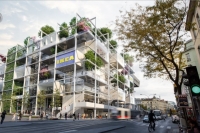IKEA Vienna 3
Client: IKEA Furniture Trading Ltd. / Thomas Lorenz ZT Ltd.
Development Period: 2013 to 2017
Next to the Viennese Western Railway Station, IKEA is currently building the world-wide innovative in-town furniture house - perfectly reachable by public transport and with a completely new store concept.
The seven-storey building complex with an almost square ground-plan area holds lateral lengths of 60 m and reaches 10 m below ground surface. A few metres below the projected foundation level, a station of the underground line U3 crosses parts of the site.
BGG Consult was first commissioned with the ground investigation and the preparation of an Geotechnical Expert's Report. For this, explorations in form of core drillings, dynamic probings, cone penetration tests, driven core probings and subsequently soil mechanical analyses were planned, supervised and evaluated. Based on the results, settlement analyses and the dimensioning of the building pit support system (intermittent bored pile wall) were conducted.
Furthermore, BGG Consult elaborated the permission documents pertaining water rights regarding the ground water drainage system for the construction.
In the building phase, expertise is provided in the context of the detailed planning.
Interaction building - existing tunnel for the underground line:
Due to the vicinity of the tunnel roof to the base of the bottom plate, special attention had to be given to the building pit support system as well as to the excavation concept. For the assessment of the deformation behaviour in the course of the excavation and during the establishment of the building, 3-dimensional calculations with the method of finite elements were conducted. In coordination with the whole design team, an excavation concept was developed with the objective to minimise the lift due to load relief. This comprised the excavation in sections, protected by braced soldier pile walls with an immediate placement of the bottom plate section after excavation.
Regarding the building pit support system, the locally missing bottom restraint due to the limited pile depth had to be considered. Thus, only a very low horizontal load could be transferred by means of the horizontal bedding, which resulted in the requirement of massive bracing measures.
December 2019
